This post is part of our special focus on east Portland this week.
In yesterday’s Monday Roundup, we linked to the most comprehensive listing I’ve seen of privileges that many people who start biking enjoy. But one item on its list is more complicated and interesting than it might seem: geographic privilege.
The point of that post, by Barb Chamberlain of Washington Bikes, wasn’t that biking is something that only privileged people do. (It’s actually the most income-diverse transportation mode in the country.) But you don’t have to spend much time on the street in east Portland to understand two things: first, that people who bike mostly in the central city enjoy lots of advantages that people around here don’t; and second, that thousands of east Portlanders are riding bikes anyway.
Let’s look at four of the forms geographic privilege takes in Portland.
1) Proximity is destiny.
This is the most obvious privilege of the central city. Portland’s central business district isn’t as important to the region as it used to be, but it still hosts about 85,000 jobs and adjoins two huge schools. As we wrote in April, Portland has made a deliberate choice to limit the number of people who can live within easy biking distance of the central city by forbidding multi-family development on almost all neighborhood streets and even a few major ones.
2) Bike shop access matters more than you think.
Above is a Google map, updated last summer, of every Portland-area bike shop location. Notice any gaps?
East Portland’s yawning bike shop desert isn’t just about a flat tire becoming an all-afternoon hassle. It’s about living four miles from anybody who can explain to you that you might want to buy a tire lever.
A bike shop desert means that you’re probably going to go bike shopping at Walmart — and you’re probably never going to realize that for an extra $200 you could buy a bike that’s 15 pounds lighter and won’t disintegrate after six months. It means the city’s ubiquitous free bike maps aren’t next to the cash register. It means not being reminded, every time you’re in a commercial district, that Portland is a city where people bike.
Advertisement
3) Portlanders are not unusually safe drivers; central Portland makes people drive safely.
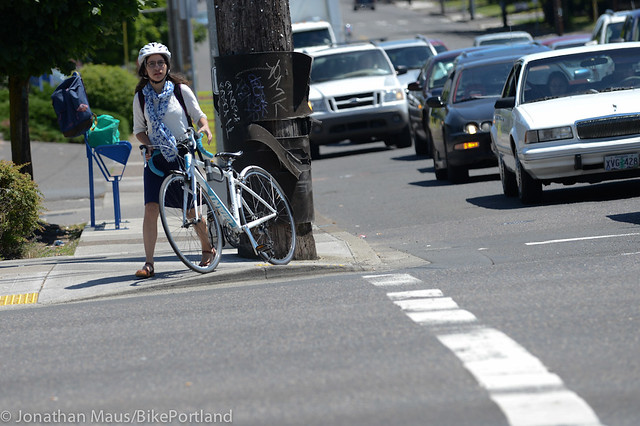
A one-hour ride down Burnside from 162nd Avenue to Grand Avenue is probably one of the fastest ways on the planet to see safety in numbers in action. The difference in bike-commute rates between east Portland (1 percent) and central Portland (20 percent) is about the same as the difference between central Portland and Amsterdam.
On Monday I was headed east on Burnside at 102nd when I met Rashed King, 27, biking downtown to his job valet parking at The Nines. Though he spends his evenings parking “Porsches and BMWs,” he can’t afford a car for his family. So he, his wife and children all ride bikes right now — but he said he’s “realistic” and plans to buy a car as soon as he can.
“Why’s that?” I asked. He answered in one word.
“Safety,” he said, smiling and shaking his head.
4) The first gift of a street grid is improvisation.
On Tuesday morning, Jonathan was at Northeast Glisan and 102nd and wanted to head south to Ventura Park’s cool new pump track. Because he didn’t know the comfortable bike routes, he did what he would have done in North Portland: headed east to the street he knew it was on, 117th, and turned south.
Bad choice: 117th doesn’t go through. He had to either continue to 122nd or turn around to 113th.
A complete street grid isn’t just a way to diffuse traffic and shorten the distance from A to B. It’s a ticket to improvise, explore, and eventually discover. That’s why east Portland’s connection problems will never be solved by lacing secret footpaths between the subdivisions. If people can’t head in a direction with a reasonable expectation of a direct connection, few of us will bother — we’ll usually just stick with what works, which is getting in a car and taking the long way around.


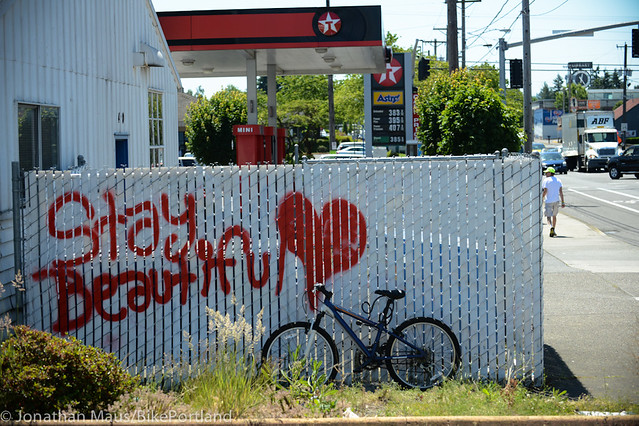

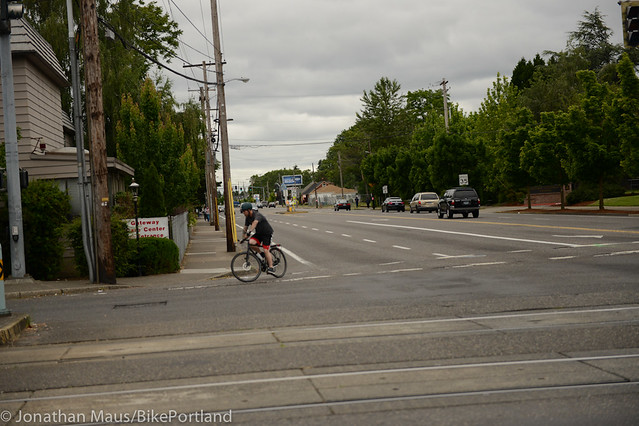
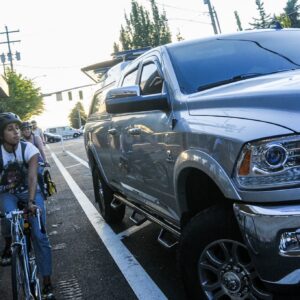
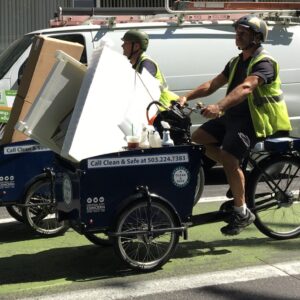
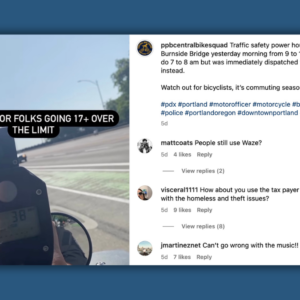

Thanks for reading.
BikePortland has served this community with independent community journalism since 2005. We rely on subscriptions from readers like you to survive. Your financial support is vital in keeping this valuable resource alive and well.
Please subscribe today to strengthen and expand our work.
“east Portland’s connection problems will never be solved by lacing secret footpaths between the subdivisions.”
Sounds like carhead to me. I think human only connections are a great way to advantage human transport. Of course I’d like to see bike paths through there too.
The Dutch maps you wrote about made a big point of giving cars the runaround, with advantage to people. I think this approach should be taken seriously here.
Yes, but when those human connections are undiscoverable, there’s low confidence of finding a usable route. Are they on google maps?
Can we use sharrows for way-finding? You can mark routes bike preferred in Google Map Maker so that’s a start.
They are if you add them! https://www.google.com/mapmaker
I do.
Google is actually better than I expected for finding such routes–even recently (well, w/in ~1 year) created ones. However, I have had exactly this problem in the western extremes. I’ve discovered cut-through pedestrian paths that are practically in my own neighborhood only after years of exploration and route study.
Problems:
1. Open Google Maps Street Quest (mapping tool of your choice) might show a path, but is it bike-friendly? Is it paved? Is it wide enough (there are some in my neck of the woods that would barely accommodate two pedestrians passing each other)? Could I take the cargo bike with groceries or kids on it? Are there curb cuts at the ends or do I have to sidewalk it to the first driveway or roll off the curb? Do I have a computer or device on which I can even search online maps? Why don’t drivers have to vet every simple route they want to take for days in advance, making test runs to be sure they won’t end up stranded or dead?
2. As implied in the article, exploration or improvisation in gridless areas is practically impossible. Either you will end up miles from your destination by following your nose along some winding Avenue (or wait–is it a Terrace? Circle? Road? Street? Court? Boulevard? Lane? Way? Drive?–They all mean different things), or you find yourself in a Twilight-Zone-ish rat-maze of cul-de-sacs, or can end up wobbling along the crumbling shoulder of a de-facto rural quasi-freeway alongside 50mph auto traffic passing you at 2 feet.
3. Those crap steel/concrete bollards at the entrances to actual MUPs. Are motorists that incredibly, insanely stupid that they cannot figure out the difference between a street and a multi-use path? Yes they are–some of them (I recall the 205 path incident)–but man, I would rather take my chances of encountering a motorist on the path than have to navigate those bollards at every turn. Before the helpful hints begin, yes I, by myself have zero trouble carefully navigating between the edge of the pavement and these bollards, but when I’m on a more unwieldy bike with wiggly passengers, or encounter oncoming [bike or pedestrian] traffic, or am a rider with less experience than me (wait, what?), they can be a minor hazard–and we don’t erect such hazards along motorways. The closest thing a motorist would have to deal with would be the entrance to a parking garage, but never the entrance to a roadway.
In conclusion, I loves me some “secret” cut-throughs, and even some MUPs for certain times/purposes, but finding them (if they exist) and using them usually takes more dedication than less-than-“avid” cyclists with access to a car are willing to invest.
Though in theory, I agree with your point.
A big part of the problem out there is that the street layout in many the neighborhoods in the outer east side just suck in general…regardless of your choice of transportation.
So in a sense they are already designed to be a pain to drivers, and bike riders, and walkers, and…..
Cul-de-sacs were designed specifically to a) maximize developable plots of land and b) for people who don’t live there to get lost, thereby limiting the number of outsiders who might venture in and burglarize homes.
From an urbanism perspective, they are absolutely horrible – and sometimes it seems like half of Portland was designed to be as convoluted as possible for navigating around the city.
Gotta say I really appreciate the coverage as there’s much more to Portland than it’s self image implies. My last comment comes from the standpoint of someone who loves Portland’s gravel streets and occasional pathway-only treatments.
I see what you’re saying Chris, and I feel much the same way you do, but while it’s relatively fun and an bit of an adventure for folk like us to find those gems, it doesn’t make sense when trying to create a legitimate network for getting from A to B. Personally, I’d rather surface streets with a direct route as opposed to foot paths through developments for my non-exploration trips.
Aren’t we talking about people who live there, who, presumably, know the local streets, and how to get around? I know I did wherever I was growing up. We, who might drop in, who don’t live there, could easily get confused but that is no different in SW Portland (where I did live for portions of my childhood). There the grid is nonexistent or has lots of gaps and non-intuitive routes.
I know of at least 2 off-street, paved pathways close to my neighborhood that bypass some of the bike-unfriendly streets around my house in Tigard (I’m looking at you, 121st, and you too, Fonner, and also you too Tigard St heading towards Main St)… but as a woman cycling alone in the early morning, I’m not going to take them.
I’m going to stick to the main streets that also get me where I want to go, most directly, and most especially where people can see me.
Maybe the locals out in Eastside also know about those secret paths, but aren’t going to take them for similar reasons.
Off-street paths are nice, but if they aren’t safe why would I take them? And if they aren’t a good, more-or-less direct connection to where I want to go, why would I deviate? As a person-on-bike, I just want to get to work and then home again when I’m commuting.
Good point. My wife similarly won’t bike down any hidden paths – she even avoids the Springwater at night. Heck, she used to bike down the middle of Barbur Blvd in traffic(!). Which I refuse to do.
Living in one place for a while is a privilege, too! Every year, 20 percent of Portlanders relocate. It’s not that secret connections are useless. But even if you learn the ones in your immediate neighborhood, sometimes you need to go new places slightly further afield. Those are the moments that add up over time to lock in dependence on the major arteries and therefore car culture, IMO.
Neri’s choice to change from vehicular traffic to pedestrian traffic (as in photo) is alarming to me as a bike and car user. People have to do what feels safe- and there are several ways to solve the problem she is shown facing. One can only be right-hooked if one is traveling to the right of a right turning machine.
That’s true. But (among other things) I think this issue plays into some of the other privileges discussed in Chamberlain’s post. If different people were to challenge a police officer’s interpretation of ORS 814.420, they might expect different sorts of reactions. Also, several east Portlanders who use bikes have told me that to take the middle of a traffic lane on a major street is to subject oneself to regular curses and honks. Different people are going to have different tolerances for that sort of thing — and it’s pretty easy to imagine someone not being up for such treatment if they have a lot of other things to worry about that day.
“If…people…challenge a police officer’s interpretation of ORS 814.420…”
“…to take the middle of a traffic lane on a major street is to subject oneself to regular curses and honks.”
Funny how we worry about the interpretation of ORS 814.420, but I doubt motorists ever give a thought to what an officer’s interpretation of ORS 815.225 (“Violation of use limits on sound equipment”), ORS 811.410 (“Unsafe passing on left”), or ORS 811.485 (“Following too closely”) might be–probably because an officer’s likely interpretation is that any cyclist actually exercising their legal rights in a lane “deserves what they get”.
How about anybody who operates a massive vehicle that is 12 times (or more) larger than appropriate deserves any delay they might suffer due to inability to navigate in traffic?
I really appreciate the focus on E Portland. Eye-opening.
Chamberlain’s list of privileges is interesting. But I still believe that biking – unlike a lot of things – also is wonderfully democratic, egalitarian, has universal appeal and low barriers to access, as I think you point out above:
“thousands of east Portlanders are riding bikes anyway.”
I think the most important ingredients she lists is learning to bike as a kid and being allowed or encouraged to go places by bike from an early age. That is both incredibly simple and need not be expensive. Although I enjoy plenty of the privileges she lists, I never had a new, much less expensive, bike until I bought myself one in high school, and still ride it 25 years later.
* Need a bike but don’t have or want to spend a wad? Craigslist, folks.
* Don’t know anything about bikes and are intimidated by the thought of buying one used? Take a friend along who knows bikes.
Thanks for posting this and creating discussion about bicycling and privilege. I think it’d be interesting to look at West Portland (more so South West) and Portland Suburb as well (Lake O, Oregon City, West Linn, etc). I live on the border of Portland and Lake O as a graduate of Lewis & Clark College and have yet to move off “the hill,” mostly because the place I’m living in now is far nicer and cheaper than one closer to downtown, thus this already is added to my list of privileges. However, one think I and others around here lack is the culture and visibility of multiple cyclists day in and day out. There is very limited infrastructure around here (and virtually none in Lake O where I was the victim of an accident over a year ago) and even when there is, it’s impossible to do things such as make a left turn from the lane without people passing aggressively on either side, honking and cursing as they do, and descending off the hill can either be a long and slow process (Riverview Cemetery for those who are familiar, which I’ve crashed on many times in the winter months due to what I believe is poor design and management) or bomb down a 40 mph road (Taylors Ferry) and risk getting passed by an angry rush hour motorist. Certainly, we have it better out here than in East Portland as the number of drivers are fewer, but it always reminds me that Portland, as whole, is not nearly as bike friendly as it’s touted to be. Certainly, it’s “better than other cities,” but that’s like saying Rainier is better than PBR.
On the other hand, East Portland has the advantages of being largely flat; with wide roads that could, given budget and vision, accommodate the cycletracks that central Portland will probably never get; and served by MAX to enable a bike/rail commute.
I would argue that East Portland is geographically more privileged than, say, Forest Heights.
I forgot about that little bit. It certainly helps to have public transit available including during non-rush hours. It’s something that is very limited or not existent for parts of SW. At this point though, I think I’ll take MAX rail free streets if it means no more awkward intersections or being trapped in the bike lane (I’m referencing Moody Ave by OHSU.)
A correction: Barb Chamberlain moved to Seattle in 2012 for her job as Executive Director of Washington Bikes.
see:
http://wabikes.org/author/barbchamberlain/
http://biketoworkbarb.blogspot.com/p/spokane.html
Thanks!
True, the land is flatter out here. But privilege systematically predisposes individuals and communities to have things work in their favor. Our flat terrain strikes me as a coincidence rather than privilege when I look at the map of bike shops (or maps of almost any other type of basic service or indicator of community wellbeing).
Flat? Yes. Privileged? Far from it.
I do agree with you, though, that the way to prosperity will require the two very points you bring up: budget and vision. We badly need this kind of dialogue to happen and I’m grateful for everyone’s participation on this thread.
Careful with the language, boys. Using the term “privilege” here is trendy, and current, but not at all accurate. If we start attaching that word to every form of difference, it will soon be just as meaningful as “sustainable.” The four issues you identify are real, but hardly examples of “privilege.” And, if you’re really concerned about a lack of bike shops, why not talk to some bike shops about why they haven’t tapped this presumably untapped territory, something 7-11 would never allow to happen.
Ethan
Thank you. I have the same sentiment. We just need to work “repair culture” into the discussion as well 🙂
Agreed. These are challenges for East Portlanders, but they are not tacit assumptions and biases that support one group and present challenges to another. That’s usually what’s meant by “privilege,” especially in the context of an article adding to an article that takes the knapsack analogy and applies it to cycling.
Maybe “advantage” is a better word?
Probably “advantage” is a better, less confusing, word than “privilege”.
So I should have written than East Portland’s geographic “advantages” include flat terrain, wide streets and MAX service.
Flattness is a big advantage! All the cycle infrastructure in the world is not going to get many people to huff and puff their way up a 10% grade.
(Of course, e-bikes can help with that.)
Thanks, Ethan and others – these are reasonable points. Our conversation about this on Tuesday grew out of the WAbike article mentioned at the top, so I guess that influenced our choice of word here. I agree that there’s a danger of overusing this word and concept.
It kills me to see people riding those full-suspension, creaky, 5mph, $200 big box bikes. Bikes can be such tools of empowerment, but if all you know is to go to Walmart and get something affordable, you’re being presented with the cycling experience at its worst. But because there’s no critical mass of cyclists, people don’t think to (or have friends to help them) hunt down a nice Craigslist bike. Buying used is also hard if you don’t have good transportation to begin with.
Which is the whole reason for organizations like the Community Cycling Center. Of course, in the 20 years its been there, Alberta got tres chic and all the poor people were pushed out further east. Maybe the CCC should relocate, or better yet, open up a second location somewhere around 122nd. I’m sure it’s been considered, and it just doesn’t pencil out. But it’d be nice.
oh please.
i have a stable of custom builds in which every single part has been lovingly selected by me based on 4 decades of using bikes as my primary form of transportation. nevertheless, i could sell these bikes and commute on a cheap bike-shaped object (BSO) with absolutely no real problem — if i had to. on bike forums there are countless threads where individuals commute on them for years. the only real issue with bike shaped objects is that they are often assembled incorrectly. but this is nothing that anyone with a modicum of mechanical skill or $10-20 at a co-op or lbs cannot fix.
I don’t think we’re that far apart. CCC’s Holiday Bike Drive refurbishes a lot of Huffys and Magnas, and while they aren’t great, they’re often not terrible once given some love. I have no doubt that there are adult versions which have the potential to work fine. But poor assembly as you note is a huge problem, and so are the horrific suspension components. You could say that the solution is easy, but it’s only easy because you know the solution. Reality is that plenty of people ride these horrible creaky things around, very slowly.
It’s like when Obama said that the nation could save all the oil we aren’t getting because of restrictive drilling policies by just making sure that we maintained appropriate tire pressure. While that may be true, and while it’s an easy fix, that doesn’t mean that everyone’s going to start maintaining proper tire pressure.
shuppatsu, we aren’t that far apart. i should note that used bikes in this town are often priced fairly high, so for some a bso is the most affordable option. it would be fantastic to see ccc open a branch in east portland.
Bike shops go where there are bicyclists who need their services. More bicyclists ride where bicycle infrastructure is stronger. So, a city’s investment in infrastructure can have an impact on how and where bike shops and other bike businesses grow.
The consequence of focusing on building bike infrastructure to reduce car trips into the central city has resulted in robust businesses that support that market. That is great success story on the one hand. On the other hand, some people and neighborhoods remain underserved.
That is lamentable. It is also an opportunity for innovation.
Thanks Alison. Well stated. We in east Portland have worked very hard for a very long time to establish a better active transportation infrastructure. East Portland is primed for better biking facilities that provide for safer transportation, not only for cyclists, but for pedestrians using the crossings that come with the new bike facilities. So glad people people are taking notice and I hope they will find that east Portland is a great place to live and raise families. It is indeed a great opportunity!
There’s no bike lane in that photo.
Probably meant ORS 814.430 (improper use of lanes), which is also subject to interpretation of the word “practicable”, and has all the same ambiguities in its exceptions as 814.420.
The largest issue that currently plagues the east side, is the historical viewpoints. I have lived in lents most of my life, and have been strictly car free for the last 13 months. Therefore as a resident at the door to the east county, who also works downtown, and attends school at MHCC. I have found an experience that is slightly different.
I find that while the east side is as flat as a sunday pancake coming from downtown you will also ride into the east wind from the gorge. Takes a little to get use to. Flat is also another way of viewing distance, and the distance presents an issue especially if you work further out, or have a large family to transport. My current commute is 13 miles round way which is not that bad.
Stark Street is a great thoroughfare and has lots of bike lane in Gresham, but when it hits portland the speed goes to 45 and the curb is for parking. Otherwise Stark is a nice east/west travel lane. It is nice that the 130’s project is happening, because that area does need a through fair for the north south situation.
Secret trails tend to lead to some weirdos lair, so no think you. Yes as a long time resident I know the east side ok. I also have to still use a map when traveling to other parts of the city that I have not lived in so learning an area is a process.
There are many positive elements that have been added to the east side, but none of those elements are going to off set an individual’s concerns on health, distance, weather, and fitness to keep the list short. While the concerns are valid they can be overcome with patience.
We will also have to confront the historical reality that the biggest barrier in the east county is a lack of political leverage when it comes to the budget allocation from city hall. The process has started, but now it is largely up to us as community members to use what has been provided.
“While the concerns are valid they can be overcome with patience.”
This matches my sense too and I’m glad you made this point. Sometimes I think we lose sight of the fact that biking can be a simple, inexpensive, autonomous activity that has the potential to empower people who try it.
When I was in sixth grade I started biking to school. Before that I’d walked and taken the train (this was not in the US). At the time, no one in my circle of acquaintances biked. There were no bike lanes, bike racks, or much in the way of amenities anywhere. My motivation was that I loved the autonomy. I didn’t have to wait for the bus and then walk like all my class mates. I got to experience the countryside much more directly than they did, and I quickly discovered that I could bike to other destinations as well.
Ideally we will keep both the barriers and the benefits, the pitfalls and the possibilities, in mind when having these conversations.